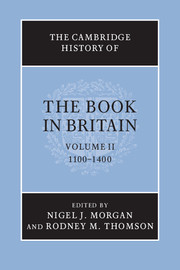Book contents
- Frontmatter
- Preface
- The roles of books
- Book production
- 3 The format of books – books, booklets and rolls
- 4 Layout and presentation of the text
- 5 Technology of production of the manuscript book
- 6 Handwriting in English books
- 7 Monastic and cathedral book production
- 8 Urban production of manuscript books and the role of the university towns
- Readership, libraries, texts and contexts
- List of abbreviations
- Bibliography
- Photo credits
- General index
- Index of manuscripts
- Plates 1
- Plates 2
- References
4 - Layout and presentation of the text
from Book production
Published online by Cambridge University Press: 28 November 2008
- Frontmatter
- Preface
- The roles of books
- Book production
- 3 The format of books – books, booklets and rolls
- 4 Layout and presentation of the text
- 5 Technology of production of the manuscript book
- 6 Handwriting in English books
- 7 Monastic and cathedral book production
- 8 Urban production of manuscript books and the role of the university towns
- Readership, libraries, texts and contexts
- List of abbreviations
- Bibliography
- Photo credits
- General index
- Index of manuscripts
- Plates 1
- Plates 2
- References
Summary
Between 1100 and 1425 there were numerous changes in the ways in which texts were laid out and presented on the page. There were new kinds of texts – a more technical literature than in previous centuries – that were often used for reference purposes as well as for continuous reading. There were also more texts in the vernacular intended for recreation as well as edification. These new texts as well as copies of older ones were produced for new generations of readers: not only for monks but also secular clergy and laymen, who had acquired a more sophisticated level of literacy through higher education, or professional training and experience. Many of these readers required easier access to details of the information contained in a text, in order to apply them to immediate problems. The way in which a text was presented on the page had to be appropriate not only to the needs of these readers but also to the content of the text. Scribes introduced new layouts and new ways of presenting texts. Some of these features first appeared in copies produced for scholars or specialist readers, but subsequently in copies of other texts (including vernacular texts) intended for a wider spectrum of readers, both male and female, to enable them to read more quickly.
- Type
- Chapter
- Information
- The Cambridge History of the Book in Britain , pp. 55 - 74Publisher: Cambridge University PressPrint publication year: 2008
References
- 7
- Cited by



